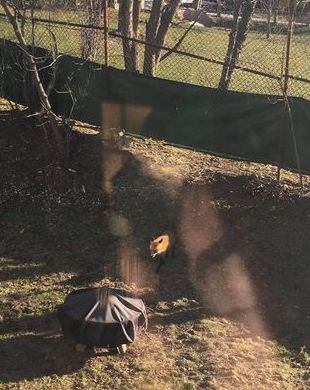
Large foxes have been seen wandering the streets of West Watertown.
Watertown News reader Tracy Scott took photos of a pair of red foxes as they walked though the backyard of her Jensen Road home, and on the streets near the park behind the Watertown Police Station (the old Browne School Playground).
“We have been living here for 4 years, we have never seen a fox here,” Scott said. “Both these foxes were large. My husband is from Vermont and even he said he has never seen foxes this big.”

Scott suspects that the foxes may be after the wild rabbits that live in her back yard. She has cats, but does not let them outside.
Foxes can thrive in urban environments, according to a story on the website of London’s The Natural History Museum. They have been known to build dens under sheds. According to National Geographic, red foxes can weigh as much as 24 pounds and be as much as 33 inches long including the head and body.
Foxes usually hunt for birds and small animals, such as rats and rabbits, according to the article, and also eat scraps thrown out by people.
Read the entire Natural History Museum article by clicking here.
Please consider checking into how photos can be enlarged by the end-user for your readers who need that in order to see them.
Thank you for your work in covering Watertown, it is appreciated
Thanks for you note. These images are not that high resolution. Normally I would have them a bit larger. I will keep that in mind.
Thank you. I am definitely not asking that you compromise the quality of the photos. Just that you look into whether the digital formatting allows us as end-users to enlarge the photos for our own viewing. Not everyone needs that, but for those of us who do, digital content can sometimes be inaccessible. Thank you for considering.
Admittedly, I’m city-born and Watertown is the leaf-iest community I’ve ever lived in, so, correct me if I’m wrong, I thought these animals were nocturnal, and if you saw one in the daytime it meant it was rabid. The expression, a ‘friendly’ fox is a rabid fox is what I heard.
Good question, Joe.
Urban living changes animal behavior (including ours). Some more-nocturnal animals become more diurnal, and some more-diurnal animals become more nocturnal, according to this article: http://www.aaanimalcontrol.com/Professional-Trapper/foxdaytimesick.html
The warning you mention does hold true in general. Unless it’s been taught to approach humans for food, “friendly” behavior by a wild animal would be concerning and should be reported to the animal control officer.
We have fox visitors in Michigan. They are usually out at dusk, but we’ve seen them during the day as well.